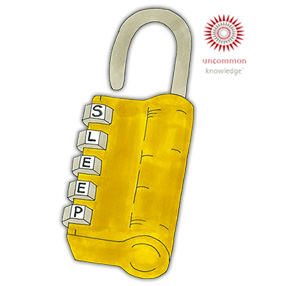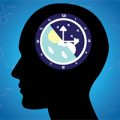
Reclaiming a healthy sleep pattern can improve your clients’ lives in wonderful ways
“That we are not much sicker and much madder than we are is due exclusively to that most blessed and blessing of all natural graces, sleep.”
— Aldous Huxley
Your pillow’s hot and lumpy. You hurl it to the floor.
You’re tossing, turning, worrying, thrashing, and sweating all of the small stuff.
The clock seems to mock you. Every minute seems to last an hour, yet somehow it’s already 4 a.m.
Wait! Is it actually getting light outside? You’ve yet to enjoy even one nanosecond of sleep.
And then you start thinking…
Must make myself sleep. Must stop thinking. Must be fresh for that meeting/hot date/’Phantom of the Opera’ audition.
Most of us sometimes struggle with wakefulness when we’d rather be asleep. And, if it’s only now and then, we can adapt to this.
But if even just one or two nights of poor sleep can make us feel fatigued, irritable, emotional, and unable to concentrate, what happens when a poor sleep pattern continues for days, weeks, or even months?
You’re losing more than just zeds
Put it this way: You on bad sleep is most decidedly not the same as you on good sleep.
Long-term sleep deprivation can increase our risk of workplace accidents(1); damage our heart and lung function(2); reduce our threshold for hallucination(3); reduce our immune function(4); cause or exacerbate mental illness(5); and maybe even precipitate weight gain(6) and type 2 diabetes(7).
You get the idea! Sleep’s vital.
So helping people to experience the astonishing healing power of deep and restorative sleep can change their lives in all kinds of wonderful ways.
We all need to know about sleep. Maintaining a healthy sleep pattern gives us a solid base from which to learn, enjoy, and develop in life. And for your clients, re-engaging the super-balm of natural nourishment that is good sleep can go a long way towards overcoming their demons.
Trying to do therapy or coaching with someone who’s not getting enough sound sleep can be like working with your hands tied.
I’ve written before about attending to good sleep hygiene – inviting sleep in and making it welcome by behaving in ways that encourage healthy sleep.
But here I want to show you how you can kickstart the sleep process to make it easier to actually fall asleep in the first place.
How to kickstart the sleep process
Thirty years ago I had an old car. I don’t mean classic. I mean old. The sort of rusted, status-lowering jalopy that turned heads for all the wrong reasons.
But it wasn’t its appearance that bothered me. This car had functional issues. Something about something to do with the engine meant I always had to park it facing downhill. If I wanted my ‘passion wagon’ to actually start, flat surfaces just wouldn’t cut it. I should have moved to San Francisco!
Mind you, once the metallic ‘babe magnet’ got going, it ran like a dream. Well, maybe not quite a dream! But as long as I worked with gravity to give it the kickstart it needed to actually get going, it did the job.
So why the vehicular segue, you ask?
People often assume that to go to sleep the mind needs to become ‘still’. But actually, in the initial stages of sleep the mind becomes more active – just in a different way. And just as I was able to kickstart my old maimed motor with the help of gravity, so too we can kickstart the process of falling asleep – we just need to understand how the process works.
Riding the sleep cycle
We ‘fall’ in love, we ‘fall’ asleep, and women ‘fall’ pregnant – though admittedly we don’t really say that any more. The point is, there are many areas of life we can ‘force’, but we can’t force love, sleep, or pregnancy – much as we may try!
Some things just have to happen ‘by themselves’, though of course there is an element of letting them happen.
So in these areas of life, and when treating insomnia, we have to help the control freakery of the conscious mind move aside for a while so that the necessary unconscious processes can occur.
Recommending that someone “try to get some sleep” is tantamount to telling them to try to fall in love.
We fall. We don’t force.
Funnily enough, people sometimes actually report a sensation of falling during the early stages of going to sleep. These sudden movements are similar to the ‘jump‘ we make when startled. But there’s more to sleep than just the falling.
Sleep is an activity
Sleep is not a single, uniform entity. Up until the 1950s we believed sleep was a purely passive part of our daily lives. But we now know that during sleep our brains are very active. In a typical night, we travel through stages 1, 2, 3, and finally 4 (deep restorative sleep), with REM (dream sleep) interspersed throughout. For a physically and mentally healthy adult, REM accounts for around 20% of sleep.
But here’s the important thing. When people are awakened during the initial stages of falling asleep (leading into stage 1 of sleep), they often report having experienced flashes of dream fragments.
We don’t start having full dreams straight off, but we do seem to go through a stage of tiny little dream scenarios before we begin to relax into deeper sleep. It’s not until around 70–90 minutes into sleep that most people have their first full dream, but these tiny flashes of dreams start to happen as soon as we tip from full consciousness into the initial meandering pathways of slumber.
These fragments of REM-like experiences invariably occur on the way into sleep, as the unconscious mind takes over from conscious thinking (or worse, worrying). And this is a process that needs to be allowed to happen.
But how can this help us kickstart the process of falling asleep?
Embracing the bizarre
As a kid I was sometimes told to count sheep if I couldn’t fall asleep. The idea was that counting imaginary sheep would become so dull that sleep would take over.
As it turns out the idea itself wasn’t so bad – but the logic behind it was all wrong. It wasn’t the boredom that lilted me towards sleep. It was the act of visualization. By imagining sheep, or anything else (non-emotive), we mirror what starts to happen as we fall asleep: the experience of dream fragments.
As we drift/fall (choose your metaphor!) asleep, we have rapid, often quite bizarre visualizations and other imagined sensory episodes. This is effectively a naturally occurring hypnotic trance state. And here’s the exciting bit.
When we teach people to self-hypnotize, we are also teaching them to enter the initial stages of sleep voluntarily. Hypnosis mirrors what happens during REM sleep. The imagination is activated purposefully through hypnosis, but then is left to ‘run itself’ as we allow ourselves to fall asleep.
Many clients who listen to our hypnosis downloads tell us that they often fall asleep if they listen to them at bedtime. This doesn’t surprise me one bit. Hypnosis mirrors the natural process of falling asleep so well that if a person is already tired, of course sleep becomes irresistible.
This happens so commonly that sometimes I find I even need to recommend that people use hypnosis at other times of day to make sure they don’t fall asleep!
Here are a couple of ways to activate the imagination in order to switch off conscious processing and switch on the brain’s sleep mechanisms.
Technique 1: Take away the pressure to mimic nature
Sometimes people worry they “can’t visualize” (even though they often report having visualized during dreaming).
What I guess they mean is that they can’t seem to visualize voluntarily. And I don’t blame them. While the conscious mind can help us to begin the process of visualization, it’s no expert when it comes to inviting in dream scenarios.
Fortunately, it doesn’t need to. During early sleep onset we don’t tend to have really extended dream scenarios, but rather rapid flashes of imagery.
Imagine I ask you to close your eyes and just get a very rough approximation of, say, a blue circle. You can probably, for a split second at least, get a sense of what a blue circle looks like. You could even do it right now.
It’s that easy to start to kickstart the initial phases of sleep.
Just keep getting really quick approximations of different imagery. It doesn’t need to be some deep inner hypnotic experience. Just quick flashes here and there to begin to encourage the natural falling into sleep.
One client came to me having suffered years of late sleep onset. Like so many others, when I mentioned visualization the walls went up as he protested that he “couldn’t visualize”. So we started simple. I asked him to imagine the blue circle.
It wasn’t long before it became a nightly routine for him to go through all the colours and shapes he could think of. He soon found that he also experienced touching and even smelling these shapes as he tipped into sleep onset.
But I like to get a little more creative!
Personally I find that if I begin to visualize really bizarre images I fall asleep sooner than if I stick to simple shapes and colours. So I might for a second imagine penguins wearing straw boater hats flying in formation over the moon, or some other such impossible nonsense. Why?
People often report quite bizarre imagery when they are naturally falling asleep. It makes sense that the more closely we can approximate this natural process, the more effectively we can encourage the psychology of sleep and therefore the physiology of slumber.
Keep it simple and quick, especially if the conscious initiation of imagery is new to you or your clients. Make the imagined dream flashes as bizarre or impossible as you like – the crazier the better, as this seems to be the best way to mirror the irrational dream imagery people have at this stage.
But as the skill of purposefully using REM states improves, we can take it further.
Technique 2: Begin the journey
The metaphor of a journey is pretty apt when it comes to sleep. We can teach people simple hypnotic journeys to follow in their minds. These could be actual journeys they are familiar with, as long as the emotional connotations are mutual, positive, or imaginary (such as following steps into a beautiful fantasy garden).
If a person’s concentration becomes diverted, perhaps by conscious worries or analysis, they can simply start the imaginary journey over, or revert to the kind of flash-imagery described above.
Watching or reading?
As an aside, surfing the net or watching YouTube clips or exciting movies doesn’t encourage sleep onset. Quite the opposite – the rapid-fire external imagery can actually have a stimulating, sleep-shunning effect.
On the other hand, reading a novel before sleep, which encourages the internal generation of imagery, at your own pace, can be wonderfully soporific.
Of course, worries need to be dealt with and left outside the bedroom door. And a sensible sleep-encouraging protocol needs to be followed if we are to maintain sleep once we’ve drifted into it.
But the takeaways here are that:
- We fall asleep; we don’t force it. But we can encourage sleep onset.
- Sleep isn’t a passive state but has its own unique activity. The brain doesn’t ‘switch off’ so much as ‘switch on’ in a different way.
- As we are first entering light sleep we often experience flashes of dream fragments. We can kickstart this process though the conscious use of visualization and other imaginary sensory experience.
- We can teach people to self-hypnotize, but we can also simply encourage the use of purposeful ‘flash imagery’ to mirror sleep-onset dream fragments.
Sleep can be a gentle palliative. It can be life enhancing, even life saving. We need to value and prioritize this wonderful part of nature, not by forcing it, but by letting ourselves drop into its life-affirming palm, as it nourishes, heals, soothes, and comforts – and so lifts us up.
Learn how to integrate hypnosis into your practice
Our introductory course Uncommon Hypnotherapy will give you conversational hypnosis skills that allow you to blend hypnotic techniques into any interaction. Read more here.
Master advanced hypnotic skills with Precision Hypnosis
Our Precision Hypnosis course gives you the confidence to work with the most complex or resistant clients through hypnotic phenomena, and sheds light on just how these can be useful in therapy.
Click here to be notified when the course is running.
Notes:
- D R Gold, S Rogacz, N Bock, T D Tosteson, T M Baum, F E Speizer, and C A Czeisler. Rotating shift work, sleep, and accidents related to sleepiness in hospital nurses. American Journal of Public Health July 1992: Vol. 82, No. 7, pp. 1011–1014.
- http://jap.physiology.org/content/98/6/2024.short
- http://pms.sagepub.com/content/68/3/787.short
- http://www.nature.com/nri/journal/v4/n6/abs/nri1369.html
- Gross, Kate. “Sleep deprivation and mental health.” Youth Studies Australia 1 Mar. 2008: 7. Academic OneFile. Web. 9 Sept. 2016.
- http://onlinelibrary.wiley.com/doi/10.1038/oby.2007.118/full
- http://jap.physiology.org/content/99/5/2008?ref=driverlayer.com/image









